We’ve put down a list of 10 large dog breeds for apartment that, based on their temperament, and with the right care, should have no trouble adjusting to a small space.
One very common misconception is that large dog breeds aren’t for apartments, not suited to a life in smaller spaces.
Many of us might think that the bigger the dog, the more energy it has, and thus the more physical space it needs, which isn’t the case.
However, this does lead people to think that it’s cruel to have a bigger dog when your place is more compact.
Sure, you might have a huge home with acres of space for your dog, but none of that matters if you don’t care for them properly in all aspects of their life.
Regardless of whether you live in a tiny one bedroomed apartment or a mansion with a pool, there are more important factors to consider when it comes to pet ownership.
10 Large Dog Breeds For Apartment
Many dogs are living in big houses but barely receive any attention or affection from their owners.
Their welfare is far more at risk than a well-loved and cared for a pup who lives in an apartment.
This is particularly true of rescue dogs, who will be used to living in a kennel and thus over the moon to have much more space to play and home – with loving humans! – to call their own.
Even if you want to get a puppy, so long as you consider every possibility, it’s easy to find one that will grow up happy and healthy in a small space.
Their personality, physical activity requirements, and need for attention are all characteristics which determine whether or not a pup will be happy in an apartment.
Provided a pup is mellow in personality, relatively inactive following their daily walk, and doesn’t tend to bark very much, then there is absolutely no reason why they wouldn’t be suited to a smaller home.
Some training may be required to help them along, but the same could be said for a dog of any size and shape.
Read on to find out which might be best for you, and stick around until the end for some frequently asked questions.
American Staffordshire Terrier
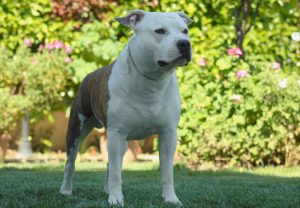
With a reputation for being one of the toughest pups around, you might be surprised to learn that American Staffordshire Terriers, or Staffies, actually have one of the most docile temperaments.
A family favorite, they are particularly fond of affection, especially if that comes from children.
Fiercely loyal and prone to being protective and territorial, they will love hanging out with you, no matter how close the proximity.
Particularly obedient and easily trained because of their higher intelligence, provided you are consistent, they are a perfect candidate for life in a smaller setting.
A firm yet gentle hand and good socialization with other dogs prevents stubborn behavior.
A commonality amongst Staffies is that they are easily bored and quick to get restless.
If you are going to leave this dog home alone, make sure they have plenty of toys to keep them occupied and ensure they have had a long walk before you go.
Otherwise, they might take their frustration out on your furniture! Daily exercise is necessary for a happy Staffy.
Greyhound
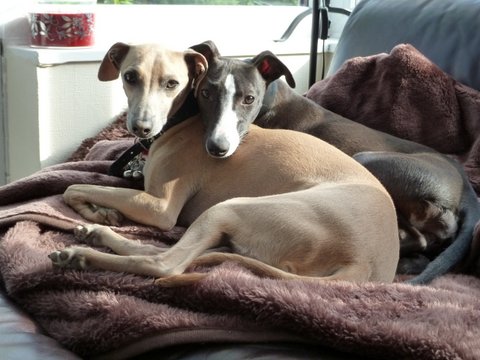
Greyhounds, particularly those now retired from a life of racing, make excellent apartment pets.
The idea that they require a ridiculous amount of exercise to stay happy and healthy is in fact quite a myth – they love to laze about on the couch with you!
A couple of short walks a day is more than enough.
When they have lived racing lives, they are used to being treated poorly and living in small, cramped kennels for the majority of the time, so an entire apartment will seem like paradise to a Greyhound.
Likewise, their shiny, short coat rarely molts and a lack of oil in their skin means they won’t stink out the room when they’re due a bath.
Laid-back and docile in temperament, they tend not to bark very much, and despite their larger size, want nothing more than to be as close to you as possible.
Prepare for a pup who will make its way into your lap and want you to stroke them non-stop!
This is useful if you have a home with less space, as a greyhound will probably want to share yours anyway!
Even if your apartment has no outdoor space or garden for your pup, they won’t mind – on rainier, colder days, it’s likely they won’t want to go outside at all and you’ll probably have to convince them to go and do their business.
Standard Poodle
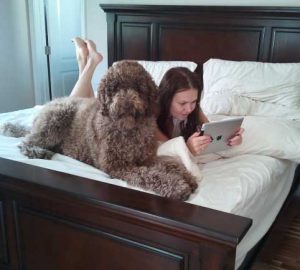
Poodles of any size can find apartment life to be enjoyable, but if you’re looking for a larger breed, your best bet is a standard.
Potentially reaching a height of fifteen inches and weight of between forty and seventy pounds, they are one of the smallest ‘large’ breeds on our list.
Though they are considered high-energy pups, a good long walk or several shorter ones throughout the day will ensure they are tired out and won’t take their excitement out on your apartment or belongings!
Providing a solid feeding and walking routine will help to minimize any distress.
As a breed that loves spending time with their owners, they are more than happy to follow you around and settle down at your feet – or in your lap – provided that they have had enough stimulation for the day.
They will eventually learn and adapt to your schedule, knowing when it is time for walkies or just a snuggle on the couch.
Although they can be easily startled by noises as a result of their strong senses and alertness, they won’t bark without cause.
So long as you teach them the difference between an intruder and someone walking around the building through desensitization training, there is no reason a poodle won’t settle down to life in an apartment.
Golden Retriever

Easily recognizable as one of the most popular breeds, especially as working service or guide dogs, Golden Retrievers are highly intelligent, good-natured, and obedient dogs who are keen to please you and very eager to learn.
Extremely friendly – sometimes to their own detriment – when well-socialized, they will get along with just about anybody, which is great if you have roommates.
Physical activity and attention are imperative for Retrievers, who will begin to misbehave if not properly stimulated or left by themselves for long periods of time.
As they are so energetic, thorough exercise multiple times a day is recommended, and they should be provided with the opportunity for a run-around to burn off some of that excitement.
This does not mean that apartment life is unsuitable for these pups, who rarely bark and, after proper training, will behave impeccably whether you are at home or not.
As long as you tire them out, provide plenty of stimulating toys to keep them active when not out for a walk, they will be perfectly happy.
Newfoundland
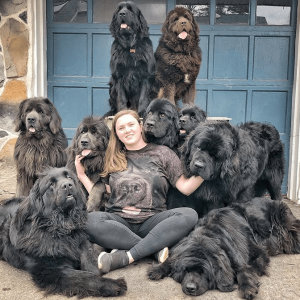
Known affectionately as Newfies, the gigantic-but-gentle Newfoundland is happiest when at their owner’s side and can usually be found there or looking for somewhere cold to take a nap.
Apartment life is perfect for them as their need for physical activity is minimal, but they have a reputation for being particularly inactive, so it is important to ensure they are exercised regularly…even if they don’t want to!
Easily bored and capable of much destruction, if you plan to leave this pup on its own whilst you’re at work, you should consider crate training to avoid coming home to a big mess every day.
If you are getting a Newfie pup rather than rescuing an older dog, there are a couple of important things to bear in mind for apartments.
Buildings with lots of stairs are unsuitable for puppies as they should avoid strenuous activity to prevent injury to their joint plates, which is easily done.
If there are only a couple of steps, that’s fine, but learning controlled use of stairs as soon as possible is necessary.
Saint Bernard
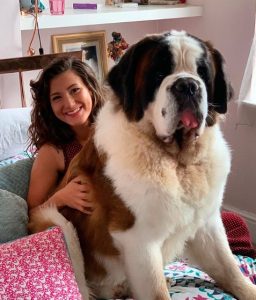
When fully grown, Saint Bernards can reach two and a half feet and weigh up to a hundred and eighty pounds, so you might think they’d be better off in a humongous house with lots of space for zooming around.
On the contrary, they are ginormous babies who love nothing more than to cozy up to their family and take frequent naps.
An easy-going, lackadaisical breed, they require minimal but sufficient exercise and are pretty inactive once they get home.
Heavy, thick coats mean they are quite prone to heat exhaustion, so access to plenty of cold water and a shady spot to lie down are imperative.
Drooling and shedding are two prominent characteristics of Saint Bernards that could cause frustration in an apartment, so be prepared to do a lot of regular vacuuming and get used to finding dribble on your sofa.
Whilst they aren’t known for barking without good cause, they do hate being left alone, so if your job means you’ll be out of the apartment most of the day, you should consider a different breed.
Boxer
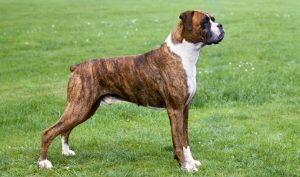
Like Golden Retrievers, Boxer dogs are often found in therapy or service jobs as they are particularly reliable and alert.
Whilst they certainly enjoy a good trip to the park for a run around, they are not outside dogs; a short and tight coat makes them particularly sensitive to hot and cold temperatures.
Prone to heatstroke, your Boxer must have access to cold water all day, especially if you live in a hotter state or don’t have air conditioning.
Boxers are especially energetic pups, particularly before the age of three, when they are at their most playful and mischievous.
With proper training, they will eventually calm down, but the younger they are, the more attention you will need to give them to prevent destructive behavior!
This does not mean they need access to a yard, however, but they certainly need your company and a couple of walks a day.
If you have a job that requires being out of the apartment all day, though, a Boxer isn’t for you.
They are happiest with their owners, as close as they physically can be to them whilst cuddled up on the couch.
Great Dane
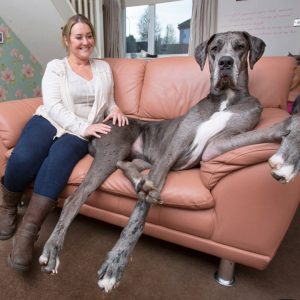
Though known for being absolutely massive, with a potential for reaching up to two hundred pounds and three feet in height, Great Danes are actually quite well suited to apartment life.
Affectionate and quiet in spite of their stature, their calm personality may come as a surprise and is perfect for those with smaller homes.
A lazy and laid-back breed that isn’t known for excessive barking, they are particularly mellow and happy enough with shorter walks, preferring to lounge around than run and play.
Combined with their short coat and minimal shedding, they are much more suited to apartment life than you might have guessed.
Their tails are long and pack quite a punch, though, so it’s easy for accidents to happen in cluttered apartments when they get excited, especially when taking into account their heavier stature and larger heads.
Bear these things in mind when considering your options – if your heart is set on a Great Dane, it could be time for a clear out!
Bullmastiff

Although they have quite an unnerving stare, bullmastiffs are renowned for being gentle giants.
Provided you can offer a daily walk, they are more than happy to laze about the house once out of that active puppy phase.
Quiet pups that rarely bark, they don’t really care for exercising. This doesn’t mean you can leave them alone all day and never take them out, of course, as this is poor dog parenting.
Quite the opposite, a Bullmastiff will want to cuddle up to you all day, believing they are lap dogs despite their heavy build.
Shedding is something to consider, as they do so regularly, but grooming these pups is easy as long as you brush them regularly.
It might be worth investing in a vacuum specifically suited for pet hair as this will save you lots of time and money in the future.
Basset Hound

To be considered a purebred Basset, a pup must grow no taller than fifteen inches, so they aren’t exactly ‘large’ dogs as determined by height.
However, their big feet, bigger bones, and potential weight of thirty-five to seventy pounds certainly qualify them for this list, we would argue.
Guided by their noses, they like to sniff around, but they aren’t as lumbering and clumsy as they might appear, stereotypically.
Mild-tempered and difficult to anger, they will usually whine quietly when something is bothering them, only barking when they feel threatened or want to protect their family.
Training is important and requires repetition with positive reinforcement to ensure your Basset adjusts to life in an apartment.
Usually pretty inactive when they are indoors, they need a fairly long daily walk to ensure they get enough exercise, but after that, they’ll be more than happy to chill with you at home.
Although they are short-haired, they can shed quite a bit, which means you’ll need to commit to plenty of vacuuming…or an existence where everything you own, including you, is covered in hair.
Dogue de Bordeaux

A strong and sturdy French breed known for their muscularity, Dogues de Bordeaux are a member of the mastiff family.
A loyal and devoted member of any clan, though, they make excellent companions and are always gentle with children.
Very well suited to a career as guard dogs, they are especially protective creatures.
If not properly socialized, however, they can become suspicious of other dogs and strangers which could lead to aggressive behavior.
This should be done as early as possible to ensure a general trust in other dogs and humans.
They are rather inactive when at home, only requiring a short walk daily for exercise, but other than that, they will not care how big your house is as long as there’s somewhere for you both to snuggle up together.
If you aren’t a fan of drool on your soft furnishings, though, definitely consider a different breed. You have been warned!
Bernese Mountain
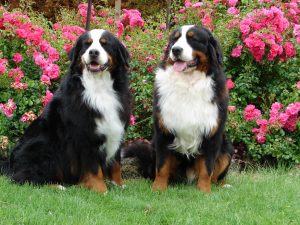
Known for having friendly faces and even friendlier personalities, Bernese Mountain dogs are kind-hearted and happy creatures that make excellent companions.
Originally bred for life in, you guessed it, the mountains, they probably would not be your first choice for an apartment dog, but it’s certainly possible when you’re equipped with the right knowledge.
Their instinct to respond to alerts means they make excellent protectors, but could also cause them to bark in response to stimuli.
It is important to consider your neighbors and ensure you train your furry friend appropriately and discourage barking at noises from above and below you.
Bernese pups can reach a hefty one hundred and twenty pounds fully grown, as well as being up to twenty-eight inches in height.
Much as you wouldn’t like it if you didn’t have room to stretch your legs a bit, make sure there’s some open space in your home and plenty of room for the dog to maneuver.
As you can imagine, they require more walking than the average dog and are happiest when they can go for a run-around three or four times a day.
They don’t necessarily have to be long walks, as their endurance isn’t as high as their desire to be outside!
If you aren’t able to provide exercise at regular intervals throughout the day, a Bernese isn’t the dog for you.
Frequently Asked Questions
If you have a large dog and you’re looking to move into an apartment, or you are yet to get a dog but have your heart set on a larger breed, then you might have a lot of questions.
We’ve collated some of the most common queries about larger dogs in smaller homes and answered them for you here.
What is considered a ‘large’ dog?
To be categorized as a large breed, dogs must weigh fifty pounds at the very least and stand at twenty-four inches tall minimum.
If a dog is referred to as a ‘giant’, it will usually weigh ninety to a hundred pounds.
How do I know if my dog is happy?
Like humans, dogs tend to express their emotions through body language, whether they are conscious of doing so or not.
A high, wagging tail is a sure sign that your pooch is in a happy mood, and one you’re probably familiar with, but there are other behaviors to watch out for.
Floppy, relaxed ears, loose shoulders, and soft eyes will also indicate a pup in a good mood, as well as acting playful and leaning into you for more attention.
Indicators that your dog is uncomfortable or unhappy are also easy to spot.
A low tail, tucked between their legs suggests stress or discomfort, as well as shrinking away and keeping their head low to the ground.
An anxious dog may also tuck their ears back flat against their head, hide behind you or another object, or even leave the room altogether.
Hyperactivity, pacing around and destructive behavior such as biting and scratching at furniture or ripping apart toys can be a sign that your dog is bored.
It may be that they need more exercise or attention from you if you, or that you are leaving them alone in the house too much.
It could also suggest that they would benefit from behavioral training, or another round if they are already trained.
How can I keep my large dog happy in an apartment?
Provided you have selected a breed well-suited to life in a smaller setting, their care needs are similar to any other dog.
A space to call their own, with a comfy bed and some toys, is essential for them to wind down and relax.
If they are crate trained, put some blankets or bed sheets in there to make it extra cozy.
Establishing a routine with your furry friend is a good way to help them settle – they are less likely to misbehave if they know when they are going to be fed or taken for a walk!
This is particularly important if they can’t relieve themselves whenever they want.
Consider aiming for an apartment on the ground floor for easy trips to the bathroom, but if that’s not possible, you could also aim for one with a balcony.
That way, you always have an emergency bathroom for when they really have to go.
If you have to be away from your pup for a large part of the day and leave them home alone, you should ensure there is a neighbor or a friend to take them for a walk and let them out to use the bathroom.
Make sure this is somebody your dog has met and trusts, or they might get upset!
Many apartment buildings will offer a shared outdoor area, and if there are other dogs in your building using this common space, it’s important that you take regular trips to the vets for vaccinations and check-ups.
Vet visits should be a part of any dog’s life, but spending lots of time in close proximity with other pups means this is even more necessary.
Depending on where you live, it might take a little while for a dog to become accustomed to the noises of your surroundings, so prioritize giving them a safe place to retreat to if they become unsettled or frightened.
Proper training, and crate training if this pup is particularly rambunctious, is recommended for the best behaved – and thus, happiest! – dogs.
Will a large dog be too noisy?
Believe it or not, it isn’t a dog’s size that determines the strength of its bark!
Some of the smallest breeds can be the loudest and most aggressive; it all comes down to training and temperament.
So long as you find the right breed and ensure you provide all necessary behavioral training, there’s no reason why a smaller dog would be quieter.
If you find that your pup is reactive to particular sounds, like people walking around above and below you, some background noise like a radio or the TV could be good to keep on while you work on getting them settled.
Likewise, if they run to the door and bark when someone knocks, a baby gate could be installed to restrict their access.
The most important thing to remember is: do not give them a reaction!
If you acknowledge your dog’s barking with a response, no matter what it is, they will recognize that barking gets your attention and do it all the more!
Teach them a simple and reliable command for calming down, such as “sh!” or “quiet!”, and try to stick to that.
Is it cruel to keep a large dog in an apartment?
As we’ve said above, some people might go out of their way to tell you that keeping a large dog in a small apartment is unnatural or unfair – this comment can come from friends and family alike.
Whilst it is an easy assumption to make, it is absolutely a false one!
Whether a dog will be happy in an apartment or not has very little to do with their size – some smaller pups might hate living in a small space, where bigger breeds that love to snuggle won’t care how much room to play they have, so long as they can snuggle up to you.
If you decide to take the plunge and rescue or buy a larger dog, be prepared to engage in this argument regularly.
People will let you know what they think regardless of whether or not it’s based in fact.
As long as your dog is happy – and you’ll know if they are or not! – then that is all that matters.
Should I get a dog if I work all day?
The answer to this question will probably be disappointing, but no.
It is recommended that a dog should not be left alone for longer than four hours at a time, for many reasons, but most simply because they’ll need to go to the bathroom!
Unless you are willing to employ a dog walker to take the pup out for daily exercise and provide companionship while you are gone, or hire a dog sitter to be with them for some of that time, it is not fair to leave them alone.
You could ask a friend or relative who likes dogs if they would be willing to do this too, but reliability is imperative for your dog’s wellbeing.
If dogs are forced to spend long periods by themselves on a regular basis, they will likely become distressed and respond with bad behavior, which wouldn’t be their fault.

